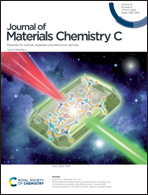Systematic study on the optimization of a bis(N,N-diethyl)aniline based NLO chromophore via a stronger electron acceptor, extended π-conjugation and isolation groups†
Abstract
A series of highly polarizable chromophores A–F based on the same bis(N,N-diethyl)aniline donor, the tricyanofuran (TCF) and CF3–Ph–TCF acceptor linked via thiophene, alkoxy chain modified thiophene and extended thiophene π-conjugations has been synthesized and systematically investigated. Density functional theory (DFT) calculations suggested that the optimal structure F showed a first-order hyperpolarizability (β) value of 551.0 × 10−30 esu which was relatively high for a single molecule. These chromophores showed good thermal stability with their decomposition temperatures all above 220 °C. By doping chromophores A–F with a loading of 25 wt% in amorphous polycarbonate (APC), electro-optic coefficients (r33) up to 149, 139, 148, 142, 252 and 305 pm V−1 at 1310 nm can be achieved, respectively. The normalized r33 value was increased to 19.37 × 10−19 pm cc per (V molecules) for F possessing alkoxy chains as the isolation group, extended thiophene bridge and CF3–Ph–TCF acceptor, indicating that the isolation groups play an important role in suppressing dipole–dipole interactions especially for those chromophores with super high β values. The largest r33 of 358 pm V−1 was achieved for chromophore F with the doping concentration of 35 wt%. The high r33 value, good thermal stability and good yield suggest the potential use of the new chromophores in nonlinear optical areas.



 Please wait while we load your content...
Please wait while we load your content...